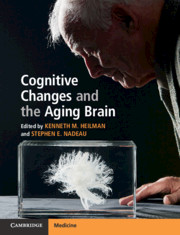Book contents
- Cognitive Changes and the Aging Brain
- Cognitive Changes and the Aging Brain
- Copyright page
- Dedication
- Contents
- Contributors
- Chapter 1 Introduction
- Chapter 2 Anatomic and Histological Changes of the Aging Brain
- Chapter 3 Cellular and Molecular Mechanisms for Age-Related Cognitive Decline
- Chapter 4 Neuroimaging of the Aging Brain
- Chapter 5 Changes in Visuospatial, Visuoperceptual, and Navigational Ability in Aging
- Chapter 6 Chemosensory Function during Neurologically Healthy Aging
- Chapter 7 Memory Changes in the Aging Brain
- Chapter 8 Aging-Related Alterations in Language
- Chapter 9 Changes in Emotions and Mood with Aging
- Chapter 10 Aging and Attention
- Chapter 11 Changes in Motor Programming with Aging
- Chapter 12 Alterations in Executive Functions with Aging
- Chapter 13 Brain Aging and Creativity
- Chapter 14 Attractor Network Dynamics, Transmitters, and Memory and Cognitive Changes in Aging
- Chapter 15 Mechanisms of Aging-Related Cognitive Decline
- Chapter 16 The Influence of Physical Exercise on Cognitive Aging
- Chapter 17 Pharmacological Cosmetic Neurology
- Chapter 18 Cognitive Rehabilitation in Healthy Aging
- Chapter 19 Preventing Cognitive Decline and Dementia
- Index
- References
Chapter 18 - Cognitive Rehabilitation in Healthy Aging
Published online by Cambridge University Press: 30 November 2019
- Cognitive Changes and the Aging Brain
- Cognitive Changes and the Aging Brain
- Copyright page
- Dedication
- Contents
- Contributors
- Chapter 1 Introduction
- Chapter 2 Anatomic and Histological Changes of the Aging Brain
- Chapter 3 Cellular and Molecular Mechanisms for Age-Related Cognitive Decline
- Chapter 4 Neuroimaging of the Aging Brain
- Chapter 5 Changes in Visuospatial, Visuoperceptual, and Navigational Ability in Aging
- Chapter 6 Chemosensory Function during Neurologically Healthy Aging
- Chapter 7 Memory Changes in the Aging Brain
- Chapter 8 Aging-Related Alterations in Language
- Chapter 9 Changes in Emotions and Mood with Aging
- Chapter 10 Aging and Attention
- Chapter 11 Changes in Motor Programming with Aging
- Chapter 12 Alterations in Executive Functions with Aging
- Chapter 13 Brain Aging and Creativity
- Chapter 14 Attractor Network Dynamics, Transmitters, and Memory and Cognitive Changes in Aging
- Chapter 15 Mechanisms of Aging-Related Cognitive Decline
- Chapter 16 The Influence of Physical Exercise on Cognitive Aging
- Chapter 17 Pharmacological Cosmetic Neurology
- Chapter 18 Cognitive Rehabilitation in Healthy Aging
- Chapter 19 Preventing Cognitive Decline and Dementia
- Index
- References
Summary
Healthy aging is accompanied by decline in a broad range of functions, including episodic learning and memory, working memory, attention, processing speed, and executive functioning. Significant efforts have therefore been made to augment these functions in healthy older adults. Two principal rehabilitation approaches have been employed: restorative and compensatory. Restorative approaches aim to repair the affected cognitive processes by repeated, adaptive practice. The majority of these restorative approaches have proved to be efficacious, and there is considerable evidence for maintenance of training effects weeks or months after the intervention was concluded. Transfer of restorative training approaches has been more elusive, although recent work has shown training effects on aspects of everyday life such as driving and instrumental activities of daily living. Compensatory approaches strive to bypass the impairment by teaching people strategies to bolster performance. Multimodal compensatory approaches that combine strategy training with counseling about other factors that affect cognition have been shown to help older adults learn new strategies, implement them to the benefit of cognitive performance, and adjust their views and expectations to better cope with the changes that occur during healthy aging.
Keywords
- Type
- Chapter
- Information
- Cognitive Changes and the Aging Brain , pp. 278 - 290Publisher: Cambridge University PressPrint publication year: 2019
References
- 1
- Cited by

